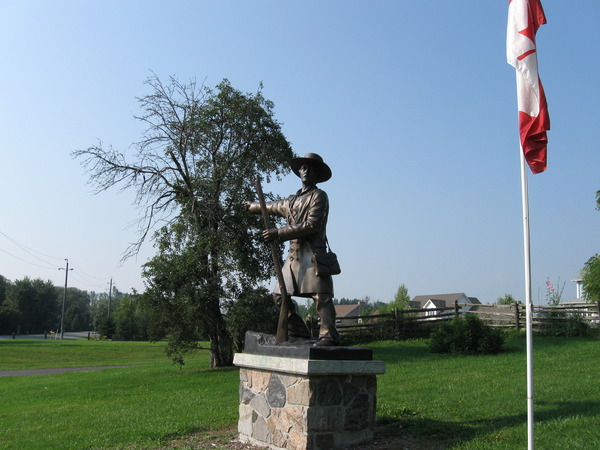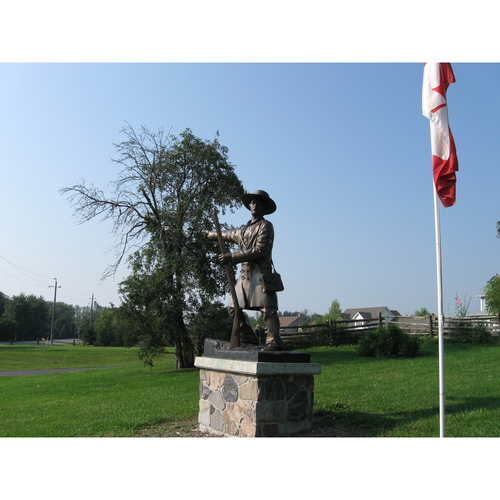
Source: Courtesy of Wikimedia Commons
LLOYD, JESSE, businessman, office holder, rebel, and farmer; b. 11 Jan. 1786 in Springfield Township, Pa, third son of William Lloyd and Susannah Heacock; m., reportedly in 1813, Phoebe Crossley, and they had at least ten children; d. 27 Sept. 1838 in Tippecanoe County, Ind.
There is some evidence to suggest that William Lloyd and his family arrived at Niagara (near Youngstown, N.Y.) in 1788 but soon returned to the United States. They probably immigrated to Upper Canada at about the same time as their youngest son, Jesse, who arrived early in 1808. Family members settled in King and Whitchurch townships, with Jesse renting a clergy reserve lot in the latter. Descended from a long line of Quakers, he joined the Yonge Street Meeting of the Society of Friends in 1814, but did not take an active role in the meeting. By renting a clergy reserve, he was violating one of the rules of the meeting, which opposed state-supported churches. He did, however, refuse to send his team of horses for use during the War of 1812, when ordered to do so, because of his Quaker beliefs.
In 1824 Lloyd bought a lot in Tecumseth Township on which he is reported to have built a sawmill. By 1828 he had turned his attentions to King Township, where his father had a sawmill and served as a township officer. Over the next five years Jesse leased, bought, or tried to buy several lots, mainly clergy reserves in the northwest part of King. On 60 acres of one lot he constructed mills, which he soon sold, and set aside numerous town-lots which he also sold, thus creating the village of Lloydtown. By the mid 1830s this had become one of the largest and most prosperous communities north of York (Toronto). Lloyd himself built a substantial brick house near the village. His success, however, did have a price. In 1836 his eye for good property involved him in a dispute with an “impoverished” widow over a clergy reserve lot, and he lost money when the Executive Council ruled against him. Five years earlier his membership in the Yonge Street Meeting had been cancelled because of non-attendance. This action appears to have ended his involvement with the Quakers, although he and his wife continued to dress in the simple garments of the members of that faith.
Political activities had increasingly occupied Lloyd’s time. Between 1829 and 1836 he held elected office in King every year but one, serving as an overseer of highways or poundkeeper or township commissioner. He also became involved in provincial politics. In 1834 he was elected to a convention to choose reform candidates for the upcoming general election. Exactly when and where Lloyd had met and become a supporter of William Lyon Mackenzie* is not known, but it probably occurred during the latter’s electoral campaigns of the early 1830s. Mackenzie was familiar with Lloydtown as early as 1831, and Lloyd, a leading voice in the area, was definitely a close friend and partisan of the reform leader by the mid 1830s.
In 1837 reformers, disillusioned with the actions of Lieutenant Governor Sir Francis Bond Head*, instigated under the impetus of the Toronto group the formation of political unions to voice the desire for reform. Lloyd was active in the King society and in forming societies in neighbouring townships. He appears to have been involved from the beginning once Mackenzie had decided there had to be a rebellion. When John Rolph* needed evidence, in October 1837, that Lower Canadian reformers were prepared to rebel, Lloyd was dispatched to Montreal to secure proof. The letter he brought back from Thomas Storrow Brown* did not contain the needed statement but Mackenzie read between the lines, insisting that there was a hidden message of rebellion. Since Lloyd made no denial, it would appear that he was cooperating with Mackenzie in his plan to push their supporters into rebellion by misinforming them.
Mackenzie met in mid November with several leading men from the Home District to convince them that there was support for an uprising and that a demonstration of forceful resolve was all that was needed to change the government. Lloyd was there, presumably supporting Mackenzie’s claims. He also helped to raise and lead a large contingent from the Lloydtown area, which became known as a hot-bed for rebellious activity. This group was said to be the best trained and most determined of the rebels who gathered at Montgomery’s Tavern north of Toronto.
Following their defeat on 7 December, Lloyd fled to the United States. A government notice offering £500 for his capture described him as having “long straight hair rather thin and turning gray – stoops very much in his gait, has scarcely any teeth left – one remarkably prominent, which is much observed when he speaks, very round-shouldered, and speaks with a strong Yankee accent, height about five feet ten or eleven inches; generally dresses in a drab or brown homespun clothing.” Lloyd’s name was so well recognized that Mackenzie used it when he drew up a list of “Provisional Government” officials on Navy Island later in December. Lloyd, however, took little or no part in events along the border. In 1838 he went to live in Indiana, where in the fall he caught a fever and died. Although he had been successful in developing Lloydtown, his estate was modest, consisting mainly of livestock, and the farm itself was only partially paid for. Since Lloyd had been an absconding rebel, his wife had to petition for the right to pay off the remainder owed so that she could retain it.
[The author wishes to thank R. Douglas Lloyd for providing additional genealogical information.
The most obvious source of information on the life of Jesse Lloyd, The bridging of three centuries: the life and times of Pheobe Crossley Lloyd – the girl bride of a rebel of 1837 ([Schomberg, Ont., 1951]; copy at AO), a pamphlet published from material gathered by Jesse M. Walton and E. Gladstone Lloyd, is perhaps also the poorest since it is filled with misinformation. Other readily available sources which are better but contain contradictions include: John Barnett, “Silas Fletcher, instigator of the Upper Canadian rebellion,” OH, 41 (1949): 7–35; M. E. Garbutt, “King Township, York County, 1800–1867: a historical sketch,” OH, 52 (1960): 85–97; an undated newspaper clipping, probably from the Banner (Aurora, Ont.), entitled “The village of Lloydtown . . .” in the York County hist. scrapbook (AO, MU 2601, no.45, 1: 131–33); and the notes on Lloyd in the C. R. Dent coll. (AO, MU 837).
Much of the story of Lloyd’s life is drawn from fragments in various document collections. His estate is itemized in his will, AO, RG 22, ser.155. Land dealings can be found in PAC, RG 1, L1, 37: 514; L3, 148: Canada Company, p.17a; 273A: K16/45, K17/18; 305: L leases, 1799–1819/18; and 305A: L leases, 1801–36/111. Further land records are available in AO, RG 1, C-IV, King Township; Simcoe Land Registry Office (Barrie, Ont.), Abstract index to deeds, Tecumseth Township (mfm. at AO); and York North Land Registry Office (Newmarket, Ont.), Abstract index to deeds, King Township (mfm. at AO). For Lloyd’s service as a municipal officer see AO, RG 21, York County, King Township, municipal minute-books, 1809–44 (mfm.). His involvement with the Quakers is recorded in Pickering College Library (Newmarket), Friends Coll., B-2-83-84, C-3-97, C-3-100. References to Lloyd and Lloydtown by William Lyon Mackenzie appear in the Colonial Advocate, 11 Aug. 1831.
Lloyd’s participation in reform activities can be studied in the Dent coll. at the AO and in the Constitution of 9 Aug. 1837. His activities in 1837 are summarized in Rebellion of 1837 (Read and Stagg). A physical description of him at this time is given in the Upper Canada Herald, 12 Dec. 1837. The difficulties over his estate are discussed in PAC, RG 1, L3, 296: L22/21. Information on family members appears in William Lloyd’s will, AO, RG 22, ser.305. r.j.s.]
Cite This Article
Ronald J. Stagg, “LLOYD, JESSE,” in Dictionary of Canadian Biography, vol. 7, University of Toronto/Université Laval, 2003–, accessed December 29, 2025, https://www.biographi.ca/en/bio/lloyd_jesse_7E.html.
The citation above shows the format for footnotes and endnotes according to the Chicago manual of style (16th edition). Information to be used in other citation formats:
| Permalink: | https://www.biographi.ca/en/bio/lloyd_jesse_7E.html |
| Author of Article: | Ronald J. Stagg |
| Title of Article: | LLOYD, JESSE |
| Publication Name: | Dictionary of Canadian Biography, vol. 7 |
| Publisher: | University of Toronto/Université Laval |
| Year of publication: | 1988 |
| Year of revision: | 1988 |
| Access Date: | December 29, 2025 |




